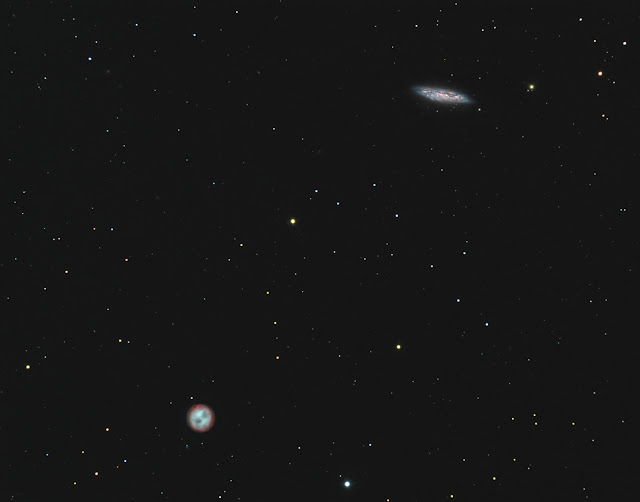Object: Messier 3 (NGC 5272)
Type: Globular cluster
Constellation: Coma Bereneces
Distance: 34,000 light years
Date: April 25th 2020
Equipment: ATIK 460EX with EFW2, Skywatcher f5.5 Esprit 100 ED refractor, Avalon Linear mount, guiding with Lodestar X2/PHD
Subframes: 20 x 150s (2x2 binned) each for RGB, flats for each channel, bias as darks (hot pixel removal in Astroart).Equipment: ATIK 460EX with EFW2, Skywatcher f5.5 Esprit 100 ED refractor, Avalon Linear mount, guiding with Lodestar X2/PHD
Globular clusters are some of the oldest objects in the universe. They consist of vast, spherical agglomerations of stars, typically hundreds of thousands in number, and exist in galactic halos in orbit around larger galaxies. The Milky Way galaxy has around 150 globular clusters in attendance, with more massive galaxies having proportionally larger numbers.
M3 was discovered on May 3, 1764, and was the first object
in the Messier catalogue
to be discovered by Charles Messier himself. Messier originally
mistook the object for a “nebula without stars”. With a larger and better
quality telescope, the object was resolved into stars by William
Herschel around 1784, who first coined the term “globular cluster”.
 |
| Stellarium map showing location of image field |
From the UK ,
M3 can be found high above the southern horizon at around midnight in late
April, between the bright stars Arcturus and Cor Caroli. The cluster
has a bright core with a diameter of about 6 arcminutes and spans a
total of 12 arcminutes (or just under the half the diameter of a full moon).
This cluster is one of the largest and brightest of its type, and is made up of
around 500,000 stars. It is estimated to be 11.4 billion years old.
I had originally planned to gather both luminance and colour
data for this object, but the seeing was very poor and I struggled to get the
auto-guiding to run below 1.3” RMS, so I restricted myself to collecting 2x2
binned sub-frames, where the guiding requirements aren’t as demanding.
However, I was quite pleased with the way the RGB image scrubbing up without any additional luminance data, so I’ve decided to let well enough be.
If you look closely, the image shows up the strange straight lines of stars that appear to run from the edges of the cluster, which Stephen O'Meara illustrated for M3 in his book "Deep-Sky Companions - The Messier Objects". It also shows up the 16th magnitude spiral galaxy NGC 5263, visible at the centre right of the main image as small fuzzy dash of light and lying some 196 million light years away...
However, I was quite pleased with the way the RGB image scrubbing up without any additional luminance data, so I’ve decided to let well enough be.
If you look closely, the image shows up the strange straight lines of stars that appear to run from the edges of the cluster, which Stephen O'Meara illustrated for M3 in his book "Deep-Sky Companions - The Messier Objects". It also shows up the 16th magnitude spiral galaxy NGC 5263, visible at the centre right of the main image as small fuzzy dash of light and lying some 196 million light years away...








